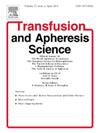The impact of second allogeneic hematopoietic stem cell transplantation as salvage therapy for hematologic diseases after a first allogeneic transplantation
IF 1.2
4区 医学
Q4 HEMATOLOGY
引用次数: 0
Abstract
Background and objectives
Acute leukemia patients who relapse after the first allogeneic stem-cell transplantation (HSCT1) have a poor prognosis. Second allogeneic hematopoietic stem-cell transplantation (HSCT2) is a therapeutic option for patients with acute myeloid leukemia (AML)/acute lymphoblastic leukemia (ALL) relapsing after HSCT1. Our aim is to evaluate the efficacy of HSCT2 in acute leukemia patients who relapsed after HSCT1.
Material and methods
In the current study, we retrospectively analyzed the data of 72 patients who underwent HSCT2. Forty-six patients with AML and 26 patients with ALL were included in the study.
Results
Before undergoing HSCT2, 47 % of patients were in complete remission. Median follow-up was 8 (1–109) months. Mortality at last follow-up was 61.1 %, and the median overall survival was 11 months (95 % CI: 1–22.9). Univariate analysis identified that age, Eastern Cooperative Oncology Group (ECOG), Body Mass Index, chimerism, conditioning regimen, CD34+ infused cell count, post-transplant cyclophosphamide usage, disease type, pre transplant hemoglobin-lymphocyte-lactate dehydrogenase-ferritin might be significant factors. After multivariate analysis ECOG (HR: 2.142; 95 % CI: 1.061–4.326; p = 0.034) was the only independent predictor for survival.
Conclusion
HSCT2 remains a feasible but high-risk treatment option for patients with relapsed acute leukemia after HSCT1. Our findings confirm that ECOG performance status is a key determinant of survival despite advances in transplantation techniques.
第二次异体造血干细胞移植作为第一次异体移植后血液病的补救性治疗的影响
背景与目的急性白血病患者首次同种异体干细胞移植(HSCT1)后复发预后较差。第二异体造血干细胞移植(HSCT2)是急性髓系白血病(AML)/急性淋巴细胞白血病(ALL)患者在HSCT1后复发的治疗选择。我们的目的是评估HSCT2治疗急性白血病患者HSCT1后复发的疗效。材料和方法在本研究中,我们回顾性分析了72例接受HSCT2的患者的资料。46例AML患者和26例ALL患者被纳入研究。结果接受HSCT2治疗前,47. %的患者完全缓解。中位随访时间为8(1-109)个月。最后一次随访的死亡率为61.1 %,中位总生存期为11个月(95 % CI: 1-22.9)。单因素分析发现,年龄、东部肿瘤合作组(ECOG)、体重指数、嵌合、调理方案、CD34+灌注细胞计数、移植后环磷酰胺使用、疾病类型、移植前血红蛋白-淋巴细胞-乳酸脱氢酶-铁蛋白可能是重要因素。多变量分析后ECOG (HR: 2.142;95 % ci: 1.061-4.326;P = 0.034)是生存的唯一独立预测因子。结论hsct2对复发性急性白血病患者在HSCT1后仍是一种可行但高风险的治疗方案。我们的研究结果证实,尽管移植技术有所进步,但ECOG表现状态是存活的关键决定因素。
本文章由计算机程序翻译,如有差异,请以英文原文为准。
求助全文
约1分钟内获得全文
求助全文
来源期刊
CiteScore
3.60
自引率
5.30%
发文量
181
审稿时长
42 days
期刊介绍:
Transfusion and Apheresis Science brings comprehensive and up-to-date information to physicians and health care professionals involved in the rapidly changing fields of transfusion medicine, hemostasis and apheresis. The journal presents original articles relating to scientific and clinical studies in the areas of immunohematology, transfusion practice, bleeding and thrombotic disorders and both therapeutic and donor apheresis including hematopoietic stem cells. Topics covered include the collection and processing of blood, compatibility testing and guidelines for the use of blood products, as well as screening for and transmission of blood-borne diseases. All areas of apheresis - therapeutic and collection - are also addressed. We would like to specifically encourage allied health professionals in this area to submit manuscripts that relate to improved patient and donor care, technical aspects and educational issues.
Transfusion and Apheresis Science features a "Theme" section which includes, in each issue, a group of papers designed to review a specific topic of current importance in transfusion and hemostasis for the discussion of topical issues specific to apheresis and focuses on the operators'' viewpoint. Another section is "What''s Happening" which provides informal reporting of activities in the field. In addition, brief case reports and Letters to the Editor, as well as reviews of meetings and events of general interest, and a listing of recent patents make the journal a complete source of information for practitioners of transfusion, hemostasis and apheresis science. Immediate dissemination of important information is ensured by the commitment of Transfusion and Apheresis Science to rapid publication of both symposia and submitted papers.

 求助内容:
求助内容: 应助结果提醒方式:
应助结果提醒方式:


